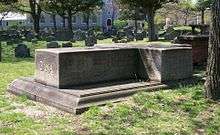Francis Dana
| Francis Dana | |
|---|---|
 | |
| United States Ambassador to Russia | |
|
In office December 19, 1780 – September 1783 | |
| Succeeded by | William Short |
| Associate Justice of the Massachusetts Supreme Judicial Court | |
|
In office 1785–1791 | |
| Preceded by | Jedediah Foster |
| Succeeded by | Thomas Dawes |
| Chief Justice of the Massachusetts Supreme Judicial Court | |
|
In office 1791–1806 | |
| Preceded by | Nathaniel Peaslee Sargent |
| Succeeded by | Theophilus Parsons |
| Personal details | |
| Born |
June 13, 1743 Charlestown, Massachusetts |
| Died |
April 25, 1811 (aged 67) Cambridge, Massachusetts |
| Resting place | Old Burying Ground, Cambridge |
| Nationality | American |
| Residence | United States |
| Alma mater | Harvard University; |
Francis Dana (June 13, 1743 – April 25, 1811) was an American lawyer, jurist, and statesman from Massachusetts. He served as a delegate to the Continental Congress in 1777–1778 and 1784. He signed the Articles of Confederation. His wife Elizabeth was a daughter of Ann Remington and William Ellery, a signer of the Declaration of Independence. He was also the father-in-law of Washington Allston, a noted painter and poet.
Biography


Francis was born in Charlestown, Massachusetts, the son of lawyer Richard Dana. He was educated at Harvard where he graduated in 1762, then read law and was admitted to the bar, after which he built a successful legal practice in Boston.
Being an opponent of the British colonial policy, he became a leader of the Sons of Liberty, and was first elected to Massachusetts’s provincial (revolutionary) Congress in 1774. In 1775 the Continental Congress dispatched him to England in an unsuccessful attempt to reconcile the differences leading to the Revolutionary War. He returned the following year, convinced that a friendly settlement of the dispute was impossible, and was elected a delegate to the Continental Congress in 1777, where he signed the Articles of Confederation in 1778. As a member of the latter body, he became chairman in January 1778 of the committee appointed to visit Gen. George Washington at Valley Forge and confer with him concerning the reorganization of the army. This committee spent about three months in camp, and assisted Washington in preparing the plan of reorganization which Congress in the main adopted. In this year, he was also a member of a committee to consider Lord North's offer of conciliation, which he vigorously opposed.
Dana left the Congress to accompany John Adams to Paris as a secretary to the diplomatic delegation.[1] In 1780 he was named as American minister to the Russian Empire, and while he never gained official recognition from Catherine the Great, he remained in St. Petersburg until 1783. After his return, he was again elected to the national congress in 1784. In 1785 Dana was appointed to the Supreme Court of Massachusetts, and served there until 1806, as the Chief Justice after 1791. An earnest advocate of the adoption of the Federal constitution, he was a member of the state convention which ratified it in 1788, and was one of the most influential advisers of the leaders of the Federalist Party, specifically its Essex Junto.
In 1792, a company was formed to build a bridge to Cambridgeport over the Charles River.[2] This became the West Boston Bridge, later the site of the Longfellow Bridge that exists today. Along with Dana, some of the original stockholders included Mungo Mackay, Oliver Wendell, James Sullivan, Henry Jackson, William Wetmore, Harrison Gray Otis, Perez Morton, Samuel Parkman, Charles Bulfinch, Joseph Blake, Henry Prentiss, John Derby, Caleb Davis, John Winthrop and Jon Austin. The bridge was opened in November 1793.
Dana generally retired from public life in 1806. He was a charter member of the American Academy of Arts and Sciences in 1780,[3] and actively supported the growth of Harvard University. His son, Richard Henry Dana, Sr., was an important poet and literary critic as well as a lawyer. His grandson, Richard Henry Dana, Jr. (1815–1882) was a noted lawyer and author who served as U.S. Attorney for Massachusetts and wrote the classic Two Years Before the Mast.
Dana died in Cambridge, Massachusetts and is buried in Cambridge's Old Burying Ground.[4]
Bibliography
- William Penn Cresson. Francis Dana, a Puritan diplomat at the court of Catherine the Great. New York: L. MacVeagh, The Dial Press.; Toronto: Longmans, Green & co, 1930
Notes
- ↑ Adams had been selected as minister plenipotentiary to negotiate treaties of peace and commerce with Great Britain.
- ↑ Oliver, Frederick L. The Bridges of the Charles. Boston. The Proceedings of the Bostonian Society. 1952
- ↑ "Charter of Incorporation". American Academy of Arts and Sciences. Retrieved 13 April 2011.
- ↑ Francis Dana at Find a Grave
External links
![]() This article incorporates text from a publication now in the public domain: Chisholm, Hugh, ed. (1911). "article name needed". Encyclopædia Britannica (11th ed.). Cambridge University Press.
This article incorporates text from a publication now in the public domain: Chisholm, Hugh, ed. (1911). "article name needed". Encyclopædia Britannica (11th ed.). Cambridge University Press.
| Wikisource has the text of the 1911 Encyclopædia Britannica article Dana, Francis. |
- United States Congress. "Francis Dana (id: D000021)". Biographical Directory of the United States Congress.
| Legal offices | ||
|---|---|---|
| Preceded by Jedediah Foster |
Associate Justice of the Massachusetts Supreme Judicial Court 1785–1791 |
Succeeded by Thomas Dawes |
| Preceded by Nathaniel Peaslee Sargent |
Chief Justice of the Massachusetts Supreme Judicial Court 1791–1806 |
Succeeded by Theophilus Parsons |
